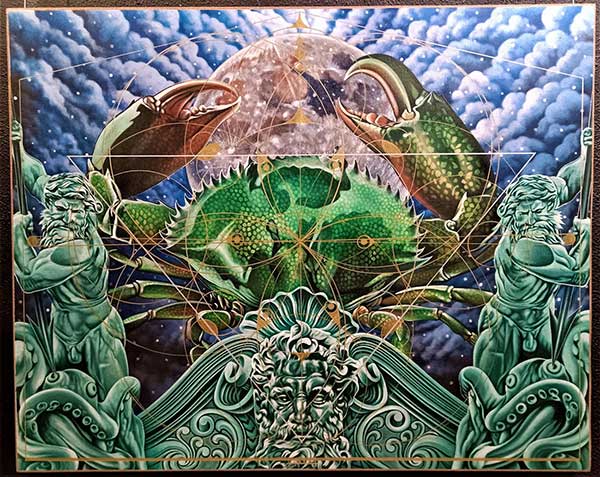
By Joriza G. Tabing and Rocelle Ann G. Terco
Yunar, the Hiligaynon word for birthmark, usually evokes nuances of identity, origin, and distinctiveness, something akin to our zodiac signs, which supposedly mirror our personality, fortune, and fate.
In this recent collection of works of Ilonggo artist, Leoniel “Sabrec” Cerbas, archetypal images are put together to reflect these astrological signs. Currently displayed on the walls of Museo Iloilo, the viewer of the artwork is drawn to its cursory form, design, color, texture, and overall aesthetics. However, as you move closer and take another look, the artwork reveals its hidden beauty: the symmetries, proportionality, balance, and order which project the narrative behind Sabrec’s brushstrokes.
The mathematics behind the brushstrokes
Growing up in the slums of Iloilo, Sabrec witnessed the struggles and difficulties of ordinary individuals who have to survive on a daily basis. These realities pushed him to express his thoughts and emotions through his artworks.
Most striking about his artworks perhaps is the incorporation and emphasis on geometric figures that reveal a mathematical adeptness in the reiteration of figures. The connection of art and mathematics in the works of Sabrec exudes deeper meanings and projects structures that showcase the beauty of art not only in its form and color but also in its order and proportion. This combination of mathematics and art creates a profound depth and structure that goes beyond mere aesthetics.
Crustacean curvatures
Let us consider one of Sabrec’s artworks from the series. Entitled ‘Cancer’, an obvious reference to the Crab, the piece exhibits a sense of bilateral symmetry, with the central axis running vertically through the center of the canvas. This is reinforced by the mirrored positioning of what seems to be statues of Neptune on both sides of the painting and by the symmetrical arrangement of the crustacean’s claws, albeit varied in dimension. A looming moon at the background further highlights this symmetry.
Numerous circles and curved lines dominate the artwork. The moon and the crab’s body form primary circular shapes, while additional smaller circles and curves overlap the scene, which creates concentric and intersecting arcs. Meanwhile, triangular forms are also subtly integrated in the painting, particularly through the connections of golden lines that overlay the image. These shapes add a layer of geometric complexity to the artwork.
More so, the distribution of the painting’s elements along the golden lines suggests a proportionality that contributes to the harmonious balance of the artwork. Also, the varying scales of elements, from the large central figure of the crab to the smaller statues and intricate details, establish a visual hierarchy. This scale draws attention to the central figures, which emphasizes them as the main subjects of the piece.
Furthermore, the painting features dynamic lines that create a sense of movement. These lines that are formed from the claws of the crab and the directions in which the statues face, converge and diverge, thus directing the viewer’s eye throughout the painting. Additionally, the intersecting golden lines, the outlines of the crab, and the positioning of the statues create numerous points of intersections that provide the viewer with a rich visual experience.
*****
Perhaps to bridge aesthetics and pedagogy, these geometric figures and concepts that can be seen in the paintings of Sabrec may be used as content for classroom instruction. In this way, teachers can integrate mathematics and art for a meaningful learning experience for students who have difficulty in understanding math-related subjects and finding its relevance to real life. Through this pedagogical approach, students may develop passion and enthusiasm towards art, as well as improve their critical thinking skills in analyzing geometrical concepts behind any artwork.
All in all, Sabrec’s artworks transcend mere artistry: it delves into the meaningful concepts behind the canvas. Inspired by the idea of yunar, he formulates his own destiny instead of relying on his fate as the stars would dictate. And as evidenced by his artworks, he masterfully creates with complexities, vibrances, and intricacies that make his paintings stand out.
[The writers are mathematics teachers taking up a doctorate degree in Philosophy in Science Education, specializing in mathematics.]




















